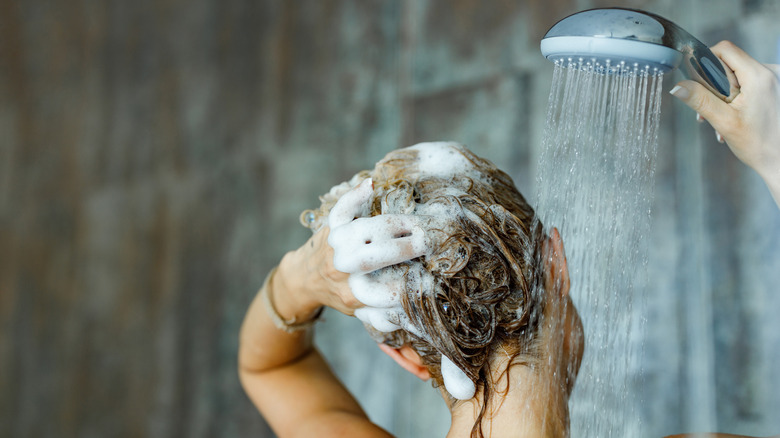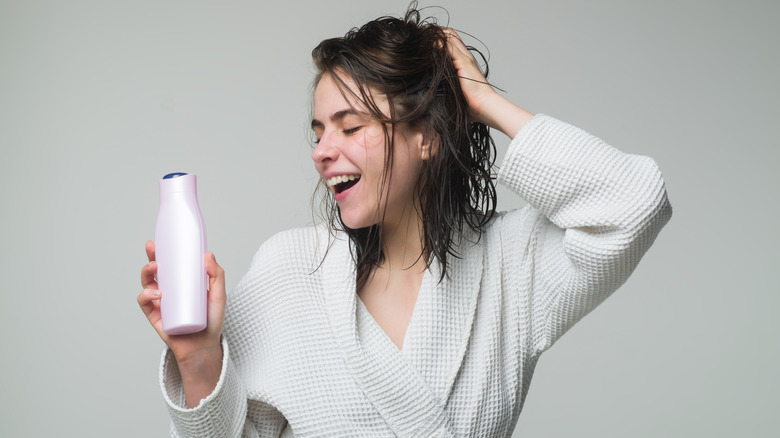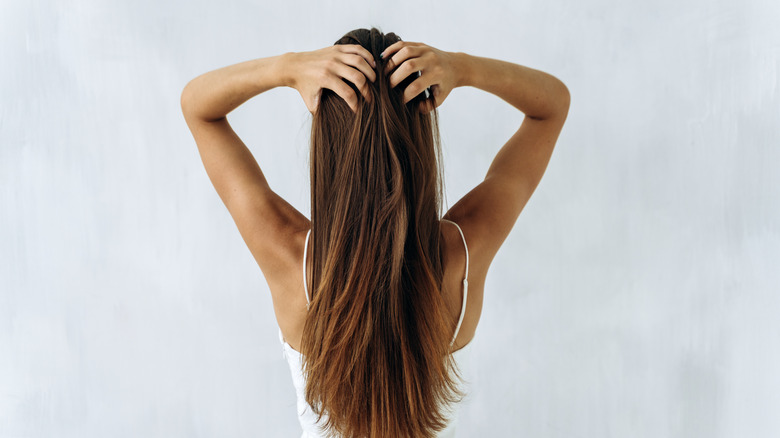The Reverse Hair Washing Technique Is Best Suited For Certain Hair Types
A good haircare routine doesn't have to be as complicated as social media often makes it out to be. You don't even need a whole shelf's worth of products. Sure, certain serums, conditioners, and masks can nourish your tresses and give them a gorgeous shine. But for many of us with busy schedules and tight budgets, they might not be viable long-term. Don't worry, though, since these products may be wonderful, but they're not must-haves.
Sometimes, simple tweaks to a standard haircare routine are all you need to make a noticeable difference. And if you think about it, the shower is where you're able to prioritize your locks without adding loads of extra time to your day. It may seem like the rules of hair washing are set in stone, but there are plenty of things you can change to help your locks reap the most benefits. To start, swap out your scalding-hot showers for cold showers that are much better for your hair.
And, instead of going straight for the shampoo after rinsing your locks, give the water about 30 seconds to a minute to soak your hair. This will allow your products to penetrate your scalp better by opening the cuticles and reducing impurity accumulation. Always keep in mind that your shampoo's primary goal is to cleanse your scalp and roots, so prioritize those during application. And, if you have especially dry or thinning hair, try reverse washing to further boost shine.
Reverse washing can offer a plethora of benefits
You've probably heard of reverse washing since it's a method that many influencers swear by. The general consensus is that it makes their hair feel soft, shiny, frizz-free, and voluminous. To perform reverse washing, you break the age-old cycle by conditioning your locks before applying shampoo. Generally, shampoos are recommended for use before conditioners because they cleanse your locks to help them better absorb the nourishment from the conditioner. And this method works great for most people, but for those with dry or fine hair, it can create a lifeless look.
This happens because the shampoo washes your hair's natural oils away, and the conditioner then coats these lifeless strands with moisture for an extra greasy, weighed-down feel. So, naturally, doing the opposite can be beneficial for fine-haired folks. Speaking to Byrdie, board-certified dermatologist Craig Ziering, DO, explained reverse washing: "The theory is based on the idea that conditioner left on first will infuse the nutrients for soft, hydrated hair strands while the porosity of the keratin protein is open from the pH of our water."
This will give your hair all the benefits of a conditioner with limited residue that can lead to greasy hair. Reverse washing can also help reduce the drying effect of shampoo as it cleanses. Every person with thin or dry hair knows the time and effort that goes into detangling after a shampoo, and conditioning first can also keep things knot-free.
What you should know before reverse washing
If you have curly, coiled, or textured hair, reverse washing might not be the best option because your hair is naturally more prone to dryness, and when you condition it at the end of your shower, you provide your curls with the moisture they need to thrive. If your hair is super dry, you may have to finish it off with a second coat of conditioner post-shampoo or even a moisturizing treatment to keep your tresses happy. And if you're worried about your hair coming out greasy, use a lightweight or leave-in conditioner.
For those looking for a fuller look, it's best to go for a volume-enhancing conditioner too. When conditioning, stick to the ends, and get some on the roots as well. When shampooing, try to keep it to the scalp as much as possible. Reverse washing can also be highly beneficial to those with chemically treated hair. As stylist Nunzio Saviano informed Shape, "This method can help to remove [heavy] oils and silicones on thinner hair types to promote more volume and help to prevent breakage and further damage to chemically treated hair by imparting a protective layer."
You can completely swap out your normal shampooing routine for a reverse wash, or simply use it on days when your hair's feeling especially dry or super greasy. However, you don't want to overdo it to see voluminous hair all the time. Stick to the number of washes you usually do.


